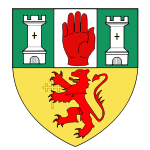Larne
Larne from Irish: Latharna, the name of a Gaelic territory)[3][4][5] Scots: Lairne is a seaport and industrial market town, as well as a civil parish, on the east coast of County Antrim, Northern Ireland, with a population of 18,755 people at the 2011 Census.[6] The Larne Local Government District had a population of 32,180 in 2011.[7] It has been used as a seaport for over 1,000 years, and is today a major passenger and freight roll-on roll-off port.[8] Larne is administered by Mid and East Antrim Borough Council. Together with parts of the neighbouring districts of Antrim and Newtownabbey and Causeway Coast and Glens, it forms the East Antrim constituency for elections to the Westminster Parliament and Northern Ireland Assembly. The civil parish is situated in the historic barony of Glenarm Upper.[9]
| Larne | |
|---|---|
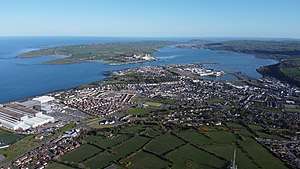 2020 view looking south-east towards Larne Harbour, Islandmagee, and down the length of Larne Lough | |
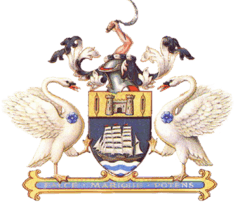 Larne Coat of Arms | |
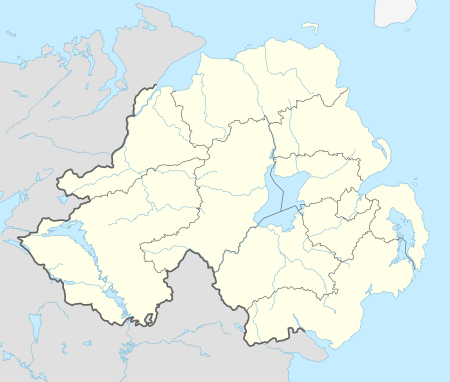 Larne Location within Northern Ireland | |
| Population | 18,755 (2011 Census) |
| Irish grid reference | D4102 |
| • Belfast | 30 km (19 mi) |
| District | |
| County | |
| Country | Northern Ireland |
| Sovereign state | United Kingdom |
| Post town | LARNE |
| Postcode district | BT40 |
| Dialling code | 028 |
| Police | Northern Ireland |
| Fire | Northern Ireland |
| Ambulance | Northern Ireland |
| UK Parliament | |
| NI Assembly | |
History
.jpg)
The coastal area around Larne has been inhabited for millennia, and is thought to have been one of the earliest inhabited areas of Ireland, with these early human populations believed to have arrived from Scotland via the North Channel. Knockdhu, north of Larne, was the site of a Bronze Age promontory fort and settlement. The early coastal dwellers are thought to have had a sophisticated culture which involved trading between the shores of the North Channel and between other settlements on the coasts of Scotland. The coast of Scotland is in fact clearly visible from here. Archaeological digs in the area have found flintwork and other artefacts which have been assigned dates from 6000 BC onwards. The term Larnian has even been coined by archaeologists to describe such flintworks and similar artefacts of the Mesolithic era (and one time to describe Mesolithic culture in Ireland as a whole).[10][11][12] Larnian is also currently used to refer to people from Larne.
Larne takes its name from Latharna, a Gaelic territory or túath that was part of the Ulaid minor-kingdom of Dál nAraidi.[13] The name spelt as Latharne was used at one point in reference to the Anglo-Norman cantred of Carrickfergus.[13] Latharna itself means "descendants of Lathar", with Lathar according to legend being a son of the pre-Christian king Úgaine Mór.[14] The town sprang up where the River Inver flows into Larne Lough. This area was known in Irish as Inbhear an Latharna ("rivermouth/estuary of Latharna") and was later anglicised as Inver Larne or simply Inver. The loch was known as Loch Ollarbha or Inbhear nOllarbha.[15] The territorial name Latharna was only applied exclusively to the town in recent centuries.
There was Viking activity in the area during the 10th and 11th centuries AD. Viking burial sites and artefacts have been found in the area and dated to that time.[16] Ulfreksfjord was an Old Norse name for Larne Lough. According to the Norse historian Snorri Sturluson, Connor, King of Ireland, defeated Orkney Vikings at Ulfreksfjord in 1018. Later anglicised names include Wulfrichford, Wolderfirth, Wolverflete and the surviving name Olderfleet. The ending -fleet comes from the Norse fljot, meaning "inlet".[17] Older- may come from the Norse oldu, meaning "wave".[17] However, P.W. Joyce in his Irish Names of Places suggests that it comes from Ollarbha, the Irish name for the loch.[18]
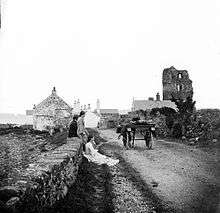
In the 13th Century the Scots Bissett family built Olderfleet Castle at Curran Point. In 1315 Edward the Bruce of Scotland (brother of Robert the Bruce, King of Scotland) landed at Larne with his 6000 strong army en route to conquer Ireland, where Olderfleet Castle was of strategic importance. Edward saw Ireland as another front in the ongoing war against Norman England.
In 1569 Queen Elizabeth I, Queen of England and Ireland, appointed Sir Moyses Hill as the governor of Olderfleet Castle. It was seen as strategically important for any Tudor conquest of Ulster. Following the 17th century Union of the Crowns of Scotland, England and Ireland under James VI & I many more settlers would have arrived to Ulster via Larne during the Plantation of Ulster. The area around County Antrim itself, however, was not part of the official 17th century Plantation; instead many Scottish settlers arrived in the area through private settlement in the 17th century (as they had also been doing for centuries before).
During the 18th century many Scots-Irish emigrated to America from the port of Larne. A monument in the Curran Park commemorates the Friends Goodwill, the first emigrant ship to sail from Larne in May 1717, heading for Boston, Massachusetts in the New England region of the modern United States of America. Boston's long standing Scots-Irish roots can be traced to Larne. The town is documented as being the first in county Antrim to be taken by United Irishmen during the ill-fated rebellion of 1798. The Protestant rebels from this area (almost entirely Presbyterian) filled Larne and engaged the government forces around 2am on the morning of 7 June. This surprise attack drove the garrison to flee the town, at which point the rebel force marched off to join up with McCracken and fight in the Battle of Antrim.[19]
In 1914, Loyalists opposed to the Home Rule Act 1914 prepared for armed resistance. In an episode known as the Larne Gun Running German, Austrian and Italian weapons with ammunition were transported into the ports of Larne and Bangor in the dead of night and distributed throughout Ulster.[20] This event marked a major step in cementing the right to Ulster Unionist self-determination, with the recognition of such a right ultimately leading to the creation of Northern Ireland.
The Troubles
Larne throughout the course of The Troubles had a significant paramilitary presence in the town, mostly through the presence of the Ulster Volunteer Force (UVF) and Ulster Defence Association (UDA). For further information see UDA South East Antrim Brigade.
The town suffered a number of Provisional Irish Republican Army (IRA) bomb attacks during The Troubles, notably including a large car bomb at the King's Arms hotel[21] in 1980 that caused damage to the main shopping areas, for which the IRA claimed responsibility. This incident was raised in Parliament at the time.[22]
Incidents which involved fatalities
- 16 September 1972: Sinclair Johnston a UVF member, was shot by the Royal Ulster Constabulary during street disturbances in the town when the Royal Ulster Constabulary were protecting Catholics living in St Johns Place.[23]
- 20 November 1974: Kevin Regan died from his injuries received in a UVF attack five days before on Maguires bar on Lower Cross Street. The Larne UDA blamed the IRA for the attack.[24]
- 6 February 1975: Colette Brown, a Catholic, was found by the side of the Killyglen Road after being shot by Loyalists.[25] Two men, one a UVF member the other a Lance Corporal in the UDR (Ulster Defence Regiment) were later convicted of her murder.[26]
- 8 September 1975: Michael O'Toole a Catholic, died from his injuries sustained in a loyalist booby trap bomb attached to his car two days previously.[27]
- 24 August 1980: Rodney McCormick a Catholic, was shot dead by the Ulster Defence Association (UDA) in the Antiville area of the town. The Royal Ulster Constabulary convicted the gunmen involved.[28]
- 11 July 2000: Andrew Cairns a UVF member, was killed by members of the UDA[29] at an eleventh night bonfire celebration in a suspected loyalist feud at Boyne Square. He may also have been murdered due to his alleged involvement in an earlier assault.[30] The Royal Ulster Constabulary detective inspector, George Montgomery, did not find any motive for the murder. David Ervine (PUP) stated that there was no Loyalist feud.[31]
Geography
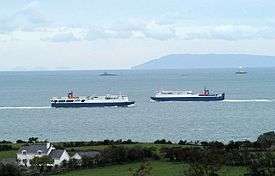
In the foreground is Islandmagee in Northern Ireland, followed by Stena Line ferries entering and leaving Larne, and The Maidens lighthouses.
In the background are the Scottish Paps of Jura on the left and Mull of Kintyre on the right.
Larne sits on the western side of a narrow inlet that links Larne Lough to the sea. On the eastern side of the inlet is a peninsula called Islandmagee. To the west of Larne is the ancient volcanic formation of Antrim Plateau, with its glaciated valleys scenically sweeping down to the sea to the north of Larne in what are known as the Glens of Antrim. Larne is 25 miles from the Scottish mainland, with stunning views across the North Channel towards the Mull of Kintyre, Rhins of Galloway, Islay and Paps of Jura often visible from the Larne area – this proximity to Scotland has had a defining influence on Larne's history and culture.
The town is within the small parish of the same name. Like the rest of Ireland, this parish is divided into townlands. The following is a list of townlands within Larne's urban area, along with their likely etymologies:[32]
- Antiville (likely from An Tigh Bhile meaning "the house of the old tree")
- Ballyboley (from Baile Buaile meaning "townland of the booley/dairy place")
- Ballycraigy (from Baile Creige meaning "townland of the rocky outcrop")
- Ballyloran (from Baile Loairn meaning "Loarn's townland")
- Blackcave North
- Blackcave South
- Curran and Drumalis (from Córran meaning "crescent" and Druim a' Lios meaning "ridge of the ringfort")
- Greenland
- Inver (from Inbhear meaning "rivermouth")
Many streetnames in Larne end in brae, such as 'Whitla's Brae' which comes from the Scots for "hillside".
Civil parish of Larne
The civil parish contains the following townlands:[9] Antiville, Ballyboley, Ballycraigy, Ballyloran, Blackcave North, Blackcave South, Curran and Drumaliss, Glebe, Greenland and Town Parks.
Gallery
Places of interest
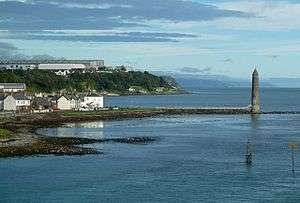
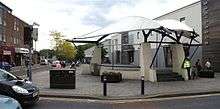
_-_geograph.org.uk_-_797992.jpg)
- The town has several parks:[33]
- The Town Park sits above the picturesque Promenade area, with walks from Waterloo Bay towards the Chaine Memorial Tower at Sandy Bay – a lighthouse and memorial to the founder of Larne Harbour sea route to Scotland. The Leisure Centre is nearby. The Promenade leads on to .
- The Chaine Park contains the burial site of James Chaine and offers picturesque views over the North Channel.
- The Curran park has a large children's play area, bowling facilities and camping. There are also tributes to emigrants to North America and Larne's connections with North America.
- The Dixon Park contains a 2 hectare open green space area with bandstand.
- Smiley park is a small park in the centre of the town also with tributes to emigrants to North America who left from the port of Larne.
- Playing fields and cricket grounds at Sandy Bay.
- Carnfunnock Country Park, 3.5 miles north of Larne is a large site with camping, caravanning, gardens, maze of Northern Ireland, sundials, children's play area, mini-golf, 9 hole pitch and putt golf course, Miniature railway, WOW balls, treasure trails, orienteering course, and walks.
- Larne Leisure Centre offers a 25m indoor swimming pool, spa, sauna, weights, fitness, sports hall and theatre. It is situated at Sandy Bay near the picturesque Promenade area.[34]
- Larne Museum & Arts Centre, situated in the Carnegie Centre in the centre of the town.[35]
- Olderfleet Castle is the ruins of a 13th-century castle at Curran Point, near the Chaine Memorial Tower.
- Cairndhu Golf Course is an 18-hole course situated atop of Ballygally Head.[36] Larne Golf Course on sits atop of the Islandmagee peninsula[37]
- Nearby sandy beaches at:
- Sandy Bay (small beach)
- Drains Bay, just to the northern edge of the town.
- Ballygally, 5 miles north from centre of Larne. Ballygally Beach has recently won top awards for cleanliness[38] and is rated to have top water quality for bathing.
- Browns Bay at the tip of Islandmagee formerly offered camping and caravanning (campsite closed 2015).
- Glenarm, 10 miles north from centre of Larne.
- Carnlough, 12 miles north from centre of Larne.
- Waterfalls and forest walk are at nearby Glenoe, 5 miles inland.
- Magheramorne, 5 miles to the south along Larne Lough, has a marina; a Mountainbiking course and an all-Ireland diving centre are currently under construction at the old Magheramorne lime quarry and cement works.[39] The film studio at Magheramorne was used to film much of HBO TV Series Game of Thrones, where the quarry wall was used as a back-drop for much of the series, along with scenery at the Antrim Plateau near Cairncastle.
- Diving tours are also available off the coast. The lighthouse on The Maidens rocks hosts a colony of seals. Numerous coastal bird species and other wildlife such as otters, whales and dolphins are often visible along the Larne coastal area.
- Castle and estate of the Earl of Antrim in the nearby fishing village of Glenarm, 12 miles north, has walled gardens and often hosts Ulster Scots cultural events such as the Dalriada Festival and Highland Games.
- Larne Lough is a protected bird-watching area and designated Special Protection Area, Area of Special Scientific Interest and Ramsar wetland site to protect both birds and shellfish.
- There are numerous stables horse-riding facilities in the area and pony trekking tours are available.
Churches
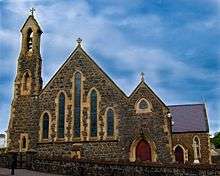
There are a number of Christian churches in Larne, including the following in alphabetical order:
- All Saints' Church. This Church of Ireland parish church was constructed in 1962 in the then newly built Craigyhill estate[40] with a hall added in 1971. It was originally a "daughter church" of the parish of St Cedma's, before being united with St Patrick's, Cairncastle, to form a new parish grouping.
- Church of God Larne. An Evangelical Pentecostal Church Located in Princes Gardens
- First Larne Presbyterian Church. This Church describes itself "as one of the oldest Presbyterian congregations in Ireland "[41] on its website. It is the home of the Larne music festival.[42]
- Gardenmore Presbyterian Church. Gardenmore is one of three Presbyterian Churches in the town of Larne. Although Presbyterians have been in Larne since the early 1600s, nothing is known about the origins of the congregation, although the church is believed to have been in existence for some years prior to the building of a meeting-house in 1769.
- Craigyhill Presbyterian Church
- Larne Baptist Church
- Larne Congregational Church. This church was founded in 1879 by Rev James Orr, but nothing is recorded about other founding members and nothing is known about Rev Orr except that his time as minister lasted for six years until 1885 and that he had died before February 1910 when the new church was built at 38–40 Curran road. Before this there was an old tin/iron building on the Clonlee which was the original meeting place. It was known as the tin tabernacle. After it became unusable due to rust and decay, the church members met at 139 Main street in the town and some meetings were held in Rev Archibald Mackinlay's home at 20 Clonlee. Around this time (1900 approx) monthly meetings were being held in the Intermediate school at Barnhill. This school was actually the end house in the terrace beside the Orange hall and is now a house again.
- Larne Elim Pentecostal
- Larne Free Presbyterian Church. This church came into being as a result of a protest when the minister of Gardenmore church (Dr R.V.A. Lynas) invited two priests, Joseph Murphy and John Miley to the opening of their new church hall on Friday 2 May 1969. Two local men, Jack McKee who later was Mayor of Larne and James Strange organised a protest along with approximately 30 others who had similar convictions. Following this, on 7 November 1969, an application was made to the Free Presbyterian church of Ulster to be recognised as a Free Presbyterian congregation. Rev William Beattie was appointed as Interim Moderator. A church was later built on the Mill Brae in the town (1971–72) which was then renovated in 2011-12 and is still there providing a witness in the town.
- Larne Methodist Church. This church is one of three on the Larne Circuit. The other Churches on the circuit are Craigyhill and Carnlough Methodist Churches. The Methodist Church in Larne has maintained a presence in the town ever since visits from the founder of the Methodist Church Rev John Wesley. Methodism seeks to be "a friend to all and an enemy to none" and this is what the Larne circuit has tried to achieve through many years of ministry. The Methodist Church throughout the circuit is involved in many community and ecumenical organisations throughout the town. The previous Superintendent the Rev Andrew Kingston was always in awe of the great relationship this group built up between the churches in Larne.
- Larne Seventh-Day Adventist Church
- Old Presbyterian Church of Larne and Kilwaughter
- St. Anthony's Church
- St. Cedma's Parish Church. The oldest church in Larne is the St. Cedma's Church, the local Anglican or Church of Ireland parish church. Records show a church in the area going back to the 12th century,[43] with the current building dating from around 1350.[44] The Church has a traditional lychgate, made of Burma teak, which leads into the graveyard, featuring headstones dating back as far as 1677.[45] The Most Reverend Alan Buchanan served in the parish before being elevated to the position of Archbishop of Dublin. The site is believed to have once contained a friary.[46]
- St. MacNissi's Church. This Catholic Church was built in 1857–1859 and celebrated its 150th anniversary in 2009. It was built with basalt and sandstone dressings. It was designed by Robert Young of Belfast. There has been a church here since 1831, erected shortly after the Catholic Emancipation Act of 1829, but proved to be too small. Enlargements were made in 1905 and a thorough restoration was carried out in 1993.
Demography
On Census day (27 March 2011) there were 18,755 people living in Larne, accounting for 1.04% of the NI total.[6] Of these:
- 18.59% were aged under 16 years and 18.00% were aged 65 and over;
- 51.98% of the usually resident population were female and 48.02% were male;
- 67.03% belong to or were brought up'Protestant and other non-Catholic Christian (including Christian related) and 25.97% belong to or were brought up Catholic;
- 71.62% indicated that they had a British national identity, 30.56% had a Northern Irish national identity and 8.75% had an Irish national identity (respondents could indicate more than one national identity);
- 41 years was the average (median) age of the population;
- 17.20% had some knowledge of Ulster-Scots and 4.02% had some knowledge of Irish (Gaelic).
Industry and commerce
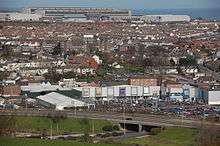
- Ballylumford power station – Northern Ireland's main power station, providing half of all Northern Ireland's electricity.
- Headquarters of Caterpillar (NI) Limited (part of the Caterpillar group) – a major employer in Northern Ireland and manufacturer of diesel and gas generators.[47]
- InspecVision Ltd. – Industrial Inspection Equipment.
- TerumoBCT – Japanese manufacturer of intravenous drip solutions and blood products.[48]
- LEDCOM (Larne Enterprise Development Company) and business park[49]
- B9 Energy – renewable energy development[50]
- Wind NI – Wind Power Development Solutions
A variety of shops can be found mainly along Larne Main Street, Dunluce Street, Laharna Retail Park, and large supermarkets off the Harbour Highway near the harbour. A variety market is also held every Wednesday at the Larne Market Yard.[51]
Transport
- Ferries sail from the harbour to Cairnryan in Scotland. Passenger services are operated by P&O Irish Sea which describes the crossings from Larne to Scotland as "the shortest, fastest crossings" due to the close proximity that Larne has to Scotland. An Irish Sea Bridge has been proposed, connecting Larne with Portpatrick in Scotland.
- Larne is connected to Belfast by the A8 road. The A2 road or 'Antrim coast road' which runs along the Antrim coast, and passes through the scenic Glens of Antrim, also serves the town. South of the town the A2 passes the side of Larne Lough, via Glynn, Magheramorne, and Ballycarry, to Whitehead and Carrickfergus. The A36 road runs from the town to Ballymena.
- The Belfast–Larne railway line connects to Belfast Great Victoria Street railway station and Belfast Central, via Whitehead, Carrickfergus and Jordanstown, also connects Larne to the Northern Ireland Railways network. Currently there is no freight transport by rail in Northern Ireland. Both Larne Town railway station and Larne Harbour railway station opened on 1 October 1862 and closed for goods traffic on 4 January 1965.[52]
- The Ballymena and Larne Railway was a narrow gauge railway. It opened in 1878, was closed to passengers in 1933 and finally completely closed in 1950. Another line ran from Larne to Ballyclare and some parts of it can still be made out where it ran along the Six Mile valley.
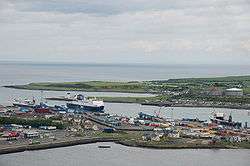 Larne Harbour from the hill at Inver.
Larne Harbour from the hill at Inver.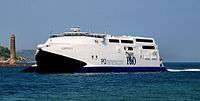 P&O "Express" fast passenger ferry entering Larne harbour.
P&O "Express" fast passenger ferry entering Larne harbour.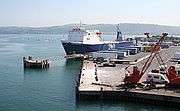 Freight ship docking at the port.
Freight ship docking at the port.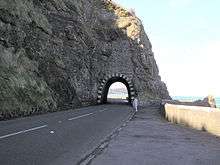 The iconic Blackcave Tunnel or "Black Arch" at the start of the scenic Antrim Coast Road at the northern edge of Larne.
The iconic Blackcave Tunnel or "Black Arch" at the start of the scenic Antrim Coast Road at the northern edge of Larne.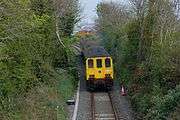 Railway just south of Larne.
Railway just south of Larne.
Education
There are a number of educational establishments in the area:
Primary Schools:
- Antiville Primary School Closed
- Cairncastle Primary School
- Corran Integrated Primary School
- Glynn Primary School
- Linn Primary School
- Larne & Inver Primary School
- Moyle Primary School
- Olderfleet Primary School
- St. Anthony's Primary School
- St. Macnissi's Primary School
- Toreagh Primary School
Secondary Schools:
Further education:
- Northern Regional College (formerly Larne Technical College)
Public services
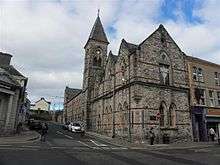
- Larne Fire Station
- Larne Library
- Larne Police Station
- Larne Ambulance Station
- Moyle Hospital (limited services after closure for accident and emergency)
- RNLI Larne Lifeboat Station
Notable people
- Nicholas Saunderson, Mathematician[53]
- Smiley Baronets, series of baronets important in History of Larne
- Dianne Barr, Paralympic Swimmer
- Billy Brown, Musician
- James Chaine Member of Parliament and Lairne's Tower, Chaine Memorial Tower.
- Dave Clements, Footballer and football manager.
- Fyfe Ewing, Musician, Drummer, formerly with rock band Therapy?
- Robert Ferguson, Disc jockey
- Keith Gillespie, Sheffield United and Northern Ireland midfielder.
- Robert John Gregg, Pioneer of the academic study of Ulster-Scots dialects as well as a linguistic authority on Canadian English
- Mark Haggan, Businessman & Charity activist
- Richard Hayward, actor, singer and author
- Valerie Hobson, actress
- Jeff Hughes, Footballer
- Michael Hughes, Wimbledon and Coventry City footballer
- Whitford Kane, actor of stage and screen
- Valerie Lilley, actor from TV programme Shameless
- Phillip Magee, The X Factor (UK series 2) finalist.
- Sir Ivan Magill, innovating anaesthetist, went to Larne Grammar school
- Dave McAuley, former IBF Flyweight world champion boxer.
- Gareth McAuley, current West Bromwich Albion defender.
- Adam McGurk, Professional Footballer
- James McIlroy Olympic runner
- Bobby McKee, Democratic Unionist Party councillor and former Mayor of Larne[54]
- Jack McKee, Alderman and Veteran Loyalist politician and brother of Bobby.
- Michael McKeegan, Musician, with rock band Therapy?
- Amanda McKittrick Ros, author and poet taught at Millbrook National School in the 1880s.
- Eddie McMorran, Footballer
- Eddie Mooney, Musician, with The Dakotas and The Fortunes.
- Hugh Nelson, Lieutenant Governor of British Columbia (1830–1893).
- Robert Nelson, electronic music producer making up half of Agnelli & Nelson.
- Jonathan Rea, world superbike rider
- Keith Semple, of One True Voice from the ITV series Popstars The Rivals.
- Harry Towb, Actor
Freedom of the borough
In memory of a battle in the town of Musa Qala in Afghanistan in 2006, involving the Royal Irish Regiment, a new regimental march, composed by Chris Attrill and commissioned by Larne Borough Council, was gifted to the regiment on Saturday 1 November 2008 in Larne, during an event in which the regiment was also presented with the 'Freedom of the Borough'.
This gave the regiment the right to march through the towns of the borough with 'flags flying, bands playing and bayonets fixed'. The march was named Musa Qala.[56]
Events in the Area
- Larne Civic Parade: On the 1st weekend in June Larne Town Centre is closed for a few hours for the annual Civic Parade where the whole town gets involved in celebrating their love for the area.
- The Goodwill Music Festival: On the 2nd weekend in May Larne Town puts on a music festival like no other. The music festival occurs over a number of days and celebrates the Irish immigration taken in the 18th and 19th centuries to the promise land of America. There is plenty of local artist on show and some national ones as well.
- Pop-Up Emporium Christmas Twilight Market: Occurs yearly in early December at the Larne Market Yard. This market is different from most others with live music and lots of local independent crafts, artisans, food, drink and other businesses involved.
- Larne Half Marathon: The annual half marathon takes place mid-March and is one of the most popular half-marathons in the Northern Ireland with most of the route taking place on the famous East Antrim Coast Road.
Sport
- Latharna Óg GAA
- Larne F.C.
- Larne Technical Old Boys F.C.
- Wellington Recreation F.C.
- Larne R.F.C.
- Larne Hockey Club
- Larne Cricket Club
- Larne Golf Club
- Cairndhu Golf Club
- Cairndhu Rowing Club
- East Antrim Boat Club
- Larne Boat Club
- Larne Bowling & Lawn Tennis Club
- Larne Athletics Club
- Larne Swimming Club
- Larne & District Game Angling Association
- Larne Archery Club
- Olderfleet Rowing Club
Twin city
Larne is twinned with Clover, South Carolina, which has named one of its schools, Larne Elementary School,[57] after Larne.
See also
References
- "Home" (PDF). Archived from the original (PDF) on 23 September 2015. Retrieved 16 April 2017.
- [Leaf through the Online Scots Dictionary http://www.scots-online.org/dictionary/read.asp?letter=L&CurPage=4]
- Larne/Latharna. Placenames Database of Ireland.
- "Postal Towns/Bailte Poist" (PDF). Archived from the original (PDF) on 7 February 2012.. Northern Ireland Place-Name Project. Queen's University Belfast.
- Room, Adrian. Placenames of the World. McFarland, 2006. p.213
- "Census 2011 Population Statistics for Larne Settlement". Northern Ireland Statistics and Research Agency (NISRA). Retrieved 10 August 2019.
- "Census 2011 Population Statistics for Larne Local Government District". Northern Ireland Statistics and Research Agency (NISRA). Retrieved 17 January 2017.
- Tibus, Website design and website development by. "Port Of Larne – About Us – History". Archived from the original on 10 March 2019. Retrieved 16 April 2017.
- "Larne". IreAtlas Townlands Database. Retrieved 20 April 2015.
- "Larne Borough council – Local History and Heritage". Archived from the original on 8 April 2015. Retrieved 16 April 2017.
- "Answers – The Most Trusted Place for Answering Life's Questions". Retrieved 16 April 2017.
- "Larnian industry – ancient culture". Retrieved 16 April 2017.
- MacCotter, Paul. Medieval Ireland. Territorial, Political and Economic Divisions. The Heritage Council. ISBN 9781846825576.
- Place Names Northern Ireland. "Larne, County Antrim". Retrieved 29 August 2016.
- "Place Names NI – Home". Retrieved 16 April 2017.
- "Fejl: Siden blev ikke fundet / adgang er ikke tilladt". Retrieved 16 April 2017.
- Geoffrey Malcolm Gathorne-Hardy. The Norse Discoverers of America. Clarendon Press, 1921.
- "Where's That?/Olderfleet 1365". Retrieved 16 April 2017.
- Hope, J., & Newsinger, J. (2001). United Irishman : the autobiography of James Hope: The autobiography of James Hope. p33-34 London: Merlin.
- A. T. Q. Stewart: "The Ulster Crisis", London, Faber and Faber Ltd., 1967 SBN 571 08066 9
- "PaceMaker Press". Retrieved 16 April 2017.
- "Terrorist Incident (Larne) (Hansard, 6 May 1980)". Retrieved 16 April 2017.
- David McKittrick et al Lost Lives page 264-265
- David McKittrick et al Lost Lives page 495-496
- David McKittrick et al Lost Lives page 514-515
- David McKittrick et al Lost Lives page 366
- David McKittrick et al Lost Lives page 575-576
- David McKittrick et al Lost Lives page 836
- UVF man shot as loyalists fall out | UK news | The Guardian https://www.theguardian.com/uk/2000/jul/13/northernireland.jamiewilson
- David McKittrick et al Lost Lives page 1478-1479
- "BBC News – NORTHERN IRELAND – Fresh appeal after bonfire murder". Retrieved 16 April 2017.
- "Northern Ireland Placenames Project". Retrieved 12 June 2010.
- "Larne Borough Council overview". Archived from the original on 8 April 2015. Retrieved 16 April 2017.
- "Leisure Centre". Archived from the original on 14 May 2012. Retrieved 16 April 2017.
- "bB査定☆超簡単に高額査定ゲット!わかりやすく解説しています". Retrieved 16 April 2017.
- "Home". Retrieved 16 April 2017.
- "Home". Retrieved 16 April 2017.
- "Ballygally and Carnlough beaches win UK awards". Retrieved 16 April 2017.
- "Magheramorne reinvented by Lafarge". Archived from the original on 28 June 2016. Retrieved 16 April 2017.
- "Diocese of Connor website including All Saints' Church". Retrieved 16 April 2017.
- "First Larne Presbyterian Church -". Retrieved 16 April 2017.
- "Larne Music Festival hits the right note". Larne Times.
- "Parish Profile". 15 May 2010. Retrieved 16 April 2017.
- "The Diocese of Connor page on St. Cedma's Church, Larne". Retrieved 16 April 2017.
- "St Cedmas Church of Ireland, Larne". Retrieved 16 April 2017.
- "Larne Council website featuring Saint Cedma's Parish Church". Archived from the original on 8 April 2015. Retrieved 16 April 2017.
- "FGW – Contact Us". Retrieved 16 April 2017.
- "Terumo BCT". Retrieved 16 April 2017.
- "LEDCOM -Expert business advice and resources in Larne and Co. Antrim". Retrieved 16 April 2017.
- Energy, B9. "B9 Energy Homepage". Retrieved 16 April 2017.
- "Larne Borough Council – Larne Market". Archived from the original on 1 April 2014. Retrieved 16 April 2017.
- "Larne stations" (PDF). Railscot – Irish Railways. Retrieved 28 August 2007.
- H F Baker, Nicholas Saunderson or Sanderson, in Dictionary of National Biography Vol L (London, 1897), 332–333.
- "Bobby McKee elected new Mayor of Larne". Larne Times. Johnston Publishing. 12 June 2008. Retrieved 11 August 2014.
- Larnite Mineral Data
- "New march to be gifted at Larne ceremony". Retrieved 16 April 2017.
- "Larne Elementary School / Homepage". Retrieved 16 April 2017.
Further reading
- Cowsill, Miles (1998). Stranraer–Larne: The Car Ferry Era. Narberth, Pembrokeshire: Ferry Publications. ISBN 1871947405.
External links
| Wikimedia Commons has media related to Larne. |
| Wikivoyage has a travel guide for Larne. |
_(geograph_6247078).jpg)


